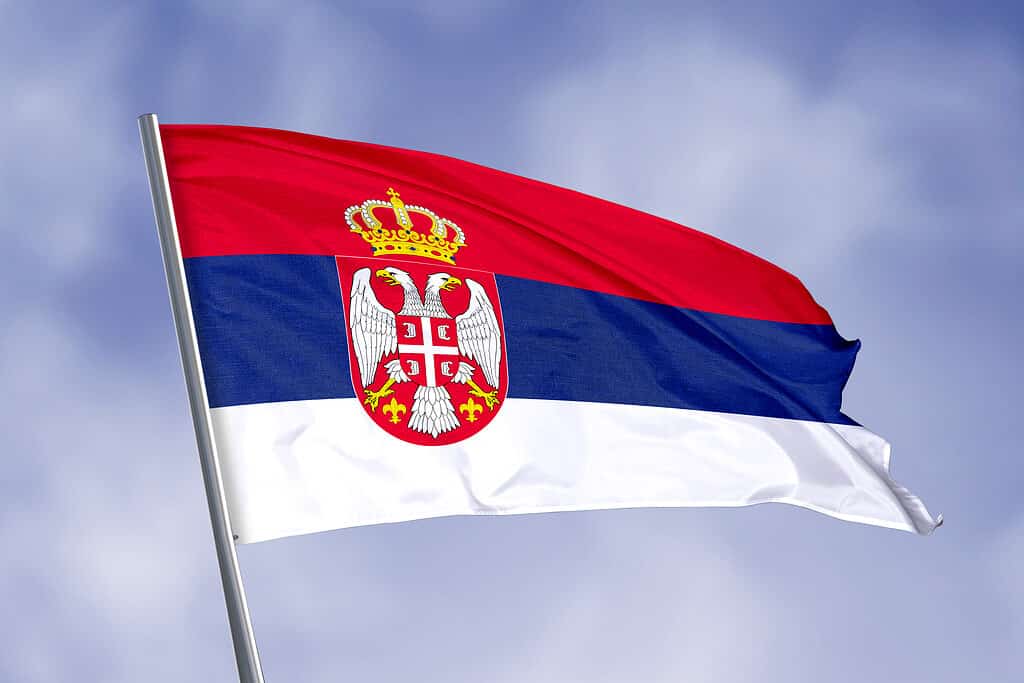Although a flag may only seem like a national symbol used to represent a country during international sports games or political events, flags are actually rich with culture and history, and every detail holds a great deal of symbolism.
Below, we’ll discuss everything you need to know about the flag of Serbia. From its appearance to its symbolism and history, this guide will cover all aspects of the Tricolor. Ready to learn more? Keep reading below!
About the Flag of Serbia
The flag of Serbia is also known as the Tricolor. This is because it is made of three horizontal bars of equal size. The top bar is red, the middle bar is blue, and the bottom bar is white. The flag’s design has remained this way since the 19th century, with some slight variations.
Unlike countries such as France or Italy, whose flags are only made up of colored bands, the flag of Serbia also includes a coat of arms with two white birds. The coat of arms is centered vertically but positioned towards the left of the flag.
Each symbol has meaning, whether the coat of arms or the individual colors. You can learn more about its symbolism below.
Symbolism in the Flag of Serbia
Though most of the symbolism found in the flag of Serbia lies in the specific colors chosen, the coat of arms is rich with symbolism, too.
The crown in the coat of arms is an ode to the past monarchy of the country, as well as Serbia’s crown of stars. This crown, along with a scepter and orb, is part of the Regalia of Serbia. These items are decorated with local gemstones and display the country’s red, white, and blue colors.
The coat of arms also incorporates a shield with four Cyrillic letters in each corner. These letters represent Samo Sloga Serbina Spasava, which translates to “Only Unity Will Save The Serbs.”
When it comes to the colors, the exact meaning behind each may vary depending on who you ask. However, the most common interpretation is that red represents the blood shed for the country, blue stands for freedom, and white symbolizes milk or sustenance.

The coat of arms incorporates a shield with four Cyrillic letters, translating to “Only Unity Will Save the Serbs.”
©tatohra/Shutterstock.com
The History of Serbia’s Flag
The very first flag of Serbia can be traced back to medieval times. On July 3rd, 1281, the son of King Stefan Vladislav sent for the king’s treasury. Treasury members returned with a list of inventories, which explicitly included a flag with the colors blue and red. While we don’t know the exact appearance of this early flag, we can see that the colors representing the nation were the same.
In 1326, however, the flag seems to have had a different appearance. Here, the current king at the time, Stefan Dečanski, used a yellow flag to symbolize war. The first image of the flag using the red double-headed eagle also originated during this time, in a map drawn by Angelino Dulcert in 1339.
However, we didn’t begin to see the early developments of the modern flag until the 19th century. During this period, Serbia underwent what is known as the First Serbian Uprising. From this conflict, many flags arose. Several included some combination of the red, white, and blue we see today, as well as the red double-headed eagle.
It was not until the 1835 Sretenje Constitution that a formal flag was outlined. The constitution describes the colors as red, white, and a “dark” color. After this was deemed too similar to the flag of other nearby countries, specifically France at the time, the description became more specific, including red, white, and blue. They also officially included the lesser coat of arms. Throughout much of the 20th century, different flag variations arose and passed.

Serbia’s past flags also featured some combination of the red, white, and blue we see today, as well as the red double-headed eagle.
©tatohra/Shutterstock.com
The Flag in Recent Years
The 1990 Constitution of Serbia stated that a specific detailed process could only change the flag. As a result, voting was required, with the absolute majority determining the outcome. This is why, years later, the red star that had become common on some forms of the flag was removed when it failed to garner the absolute majority vote.
The current flag is the result of a 2010 redesign, although very few changes have occurred in the past few decades.
The photo featured at the top of this post is © Faievych Vasyl/Shutterstock.com
Sources
- Cambridge, Available here: https://www.cambridge.org/core/services/aop-cambridge-core/content/view/50460BFAFC3593FD1261D004D720474C/S0037677900125847a.pdf/the-first-serbian-uprising-1804-1813-and-the-nineteenth-century-origins-of-the-eastern-question.pdf
Thank you for reading! Have some feedback for us? Contact the AZ Animals editorial team.






